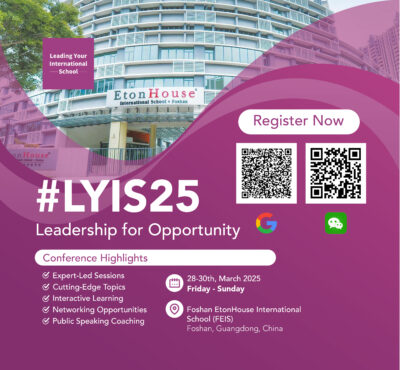by Tom Ferguson
In our increasingly connected world, international schools have a responsibility not just to teach diversity but to model it in every aspect of school life, especially in hiring. A truly global education requires an equally diverse faculty, ensuring students engage with perspectives that challenge, enrich, and expand their worldview. However, achieving a more inclusive and representative hiring process isn’t about meeting quotas or following trends. It’s about actively bringing in new voices and perspectives that make learning more relevant and meaningful for students.
With the shifting global landscape, where many organisations are re-evaluating their approach to diversity, equity, and inclusion (DEI), schools must remain steadfast in their commitment to fostering warm, welcoming environments with opportunities for all. Reading a recent article by Dr. Tristan Bunnell reminded me of how crucial this work is, not just as a best practice, but as a fundamental responsibility of international school leaders.
Reassessing Recruitment Practices
One of the first steps I took at Dwight Seoul was to honestly evaluate our hiring practices. Were we casting the net wide enough? Without realising it, many schools limit their talent pool by relying on familiar recruitment channels or selection criteria that unintentionally exclude talented individuals from diverse backgrounds. The first vacancy I filled after joining the school revealed patterns in candidate selection that suggested unconscious bias. This isn’t unique to our school, it’s an issue well-documented in research. Bertrand and Mullainathan’s (2004) study found that hiring bias can be subtle yet persistent, shaping who gets shortlisted before they even enter the interview process.
Recognising this, we expanded our recruitment strategy beyond the dominant international teacher recruitment platform, actively searching new channels to attract candidates. We posted job openings in spaces where we hadn’t traditionally looked, increasing visibility among a broader audience. Taking deliberate steps in recruitment isn’t just about filling a position, it’s about enriching the school with new perspectives. Identifying unconscious biases is an important first step, and there are accessible tools, such as Harvard’s Project Implicit, that can help hiring teams recognise and address them.
Ensuring a Fair and Inclusive Selection Process
Expanding recruitment is only the beginning. Once applications come in, the way candidates are evaluated must also be equitable. Traditional hiring practices tend to favour specific educational backgrounds or career paths, even when alternative experiences may bring equal, if not greater, value to the role.
At Dwight, we made a conscious decision to refine our selection criteria to be more inclusive and aligned with our school’s diverse needs. For example, we implemented structured evaluation methods that focus on teaching potential and character rather than relying solely on past achievements. Blind recruitment, where personal details such as names and nationalities are removed during the early stages of selection, is another effective approach to minimising bias. At Dwight, our goal is clear: to hire outstanding educators who will enrich our community, where a passport is not the defining factor in the hiring decision, and where potential and passion for teaching matter as much as experience.
Creating an Inclusive Workplace Culture
Recruiting a diverse team is only effective if the workplace fosters a sense of belonging. At Dwight, our B-JEDI (Belonging, Justice, Equity, Diversity, and Inclusion) approach puts belonging at the heart of everything we do. Community is a core pillar of our school, and that extends to faculty and staff.
Studies by Shore et al. (2011) emphasise that inclusion directly impacts employee engagement and retention. Teachers who feel valued and connected to their workplace are more committed, more innovative, and more effective in the classroom. For us, this means prioritising mentorship and a buddy program, professional development, and open dialogue about diversity. New hires from all backgrounds should feel supported and empowered from day one, not just in their teaching roles but as integral members of the school community.
Redefining Leadership: Championing Diversity in Action
Since the 1990s, although research on leadership demographics in international schools has been somewhat limited, it has consistently shown that men dominate leadership roles. This enduring pattern seems contradictory given that most international schools champion diversity, equity, and inclusion as core values. If diversity is truly at the heart of international education, then leadership structures should reflect the global, inclusive ethos that schools strive to cultivate.
At Dwight Seoul, we have been intentional in ensuring that our leadership team aligns with the values we promote. Our academic leadership team is now 80% female, representing a range of nationalities, educational backgrounds, and professional experiences. Each of these leaders is a skilled linguist, bringing a deep understanding of the importance of language, culture, and representation in an international school setting. Their diverse perspectives enrich decision-making and provide students with role models who reflect the global community they are growing up in. By ensuring that leadership mirrors the diversity we want to see in the wider world, we reinforce our commitment to inclusion and equity, not just in principle, but in practice.
The Impact of a Diverse Faculty on Students
Beyond hiring practices, diversity in the faculty directly benefits students. Page (2007) found that diverse teams bring a broader range of ideas and problem-solving strategies, leading to more creative and effective outcomes. In an international school setting, this means that students learn in an environment where they regularly engage with different viewpoints and experiences.
At Dwight Seoul, we believe in hiring educators who reflect the diversity of our student body, for example, we hire local Korean teachers not just for language teaching but in core subjects such as Mathematics and Science. Our faculty represents 19 different nationalities, providing students with role models from a wide range of backgrounds. This diversity helps students build cultural awareness, develop critical thinking skills, and better understand the interconnected world they are part of.
Additionally, a diverse faculty strengthens relationships with the broader school community. Our families feel a greater sense of connection when they see representation among the staff, knowing their experiences and cultural perspectives are understood. This fosters trust, engagement, and a stronger school culture overall.
Moving Forward with Intention
Creating an inclusive faculty isn’t a one-time effort, it’s an ongoing commitment to reflecting the values we teach in the classroom. Schools must continuously assess their hiring practices, challenge assumptions, and refine their approaches. Dwight Seoul has taken deliberate steps to build a faculty that represents the world our students will enter, but the work does not stop here.
As educators, we ask our students to be open-minded, to embrace different perspectives, and to challenge biases. It is only right that we do the same when building our teams. By rethinking recruitment, ensuring fair hiring processes, and fostering a culture of belonging, international schools can lead by example, creating communities where every student and staff member feels valued, supported, and empowered to thrive.
References
Bertrand, M., & Mullainathan, S. (2004). Are Emily and Greg More Employable than Lakisha and Jamal? A Field Experiment on Labor Market Discrimination. American Economic Review, 94(4), 991-1013.Bunnell, T. (2025, February 18). Why white men still rule in international school leadership. School Management Plus. https://www.schoolmanagementplus.com/international-schools/why-white-men-still-rule-in-international-school-leadership/ Harvard University. (n.d.). Project implicit: Take a test. Harvard University. https://implicit.harvard.edu/implicit/takeatest.html. Page, S. E. (2007). The Difference: How the Power of Diversity Creates Better Groups, Firms, Schools, and Societies. Princeton University Press.Rivera, L. A. (2012). Hiring as Cultural Matching: The Case of Elite Professional Service Firms. American Sociological Review, 77(6), 999-1022.Shore, L. M., Randel, A. E., Chung, B. G., Dean, M. A., Ehrhart, K. H., & Singh, G. (2011). Inclusion and Diversity in Work Groups: A Review and Model for Future Research. Journal of Management, 37(4), 1262-1289.
Tom Ferguson is the Head of School at Dwight Seoul.
Next week’s Principal’s Blog is written by Alissa Gouw, Secondary School Principal and Deputy Head of School, International School of Dongguan
LYIS is proud to partner with WildChina Education


